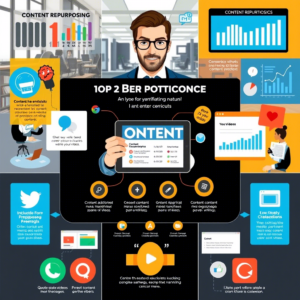In today’s digital age, standing out as a thought leader in your industry is no longer just an advantage—it’s essential. One of the most powerful tools at your disposal for achieving this goal is LinkedIn Articles.
With over 900 million users globally, LinkedIn offers professionals a unique platform to share their expertise, connect with peers, and build credibility.
But how do you leverage this feature effectively? In this article, we’ll explore practical strategies for using LinkedIn Articles to establish yourself as a respected authority in your field.
Whether you’re just starting or looking to refine your approach, these tips will help you craft compelling content that resonates with your audience.
1. Define Your Unique Voice and Niche
Before diving into writing articles, it’s crucial to identify what makes you stand out. What specific area of expertise can you offer that others cannot?
Defining your niche helps ensure your content remains focused and valuable. For instance, if you work in marketing, consider specializing in social media strategy rather than general marketing trends. This specificity allows you to speak directly to your target audience’s needs.
To make your voice distinct, think about your personal experiences, challenges overcome, and lessons learned. Sharing authentic stories not only humanizes your content but also builds trust with readers.
According to HubSpot, personalized content performs up to 20% better than generic posts because it connects emotionally with the audience.
Tip: Start by brainstorming topics where you have deep knowledge or passion. Then, ask yourself: “What problem does my expertise solve?” Use this question as a guiding principle when crafting your articles.
2. Create Content That Solves Problems
The best way to engage your audience is by addressing their pain points. Instead of merely sharing information, focus on providing actionable solutions.
For example, instead of writing an article titled “The Importance of Networking,” try something like “5 Practical Steps to Build Meaningful Professional Relationships.” The latter immediately signals value and encourages clicks.
When creating problem-solving content, break down complex ideas into digestible steps. Lists, bullet points, and numbered guides are excellent ways to organize information clearly. Additionally, include real-world examples or case studies to illustrate your points. If possible, draw from your own professional journey to add authenticity.
Example: Let’s say you’re an HR specialist discussing remote work policies. You could write:
“After implementing flexible hours for our team, productivity increased by 15%. Here’s how you can replicate success in your organization…”
This approach not only showcases your expertise but also demonstrates tangible results.
3. Engage Through Storytelling
Stories are one of the most effective ways to capture attention and create emotional connections. When writing LinkedIn Articles, weave narratives throughout your content to keep readers engaged. A well-told story can transform dry facts into relatable experiences that inspire action.
For instance, imagine you want to discuss leadership qualities. Rather than listing traits, tell the story of a time when you faced a challenging situation and how your leadership skills helped resolve it. Stories like these allow readers to see themselves in similar scenarios, making your advice more applicable.
Additionally, use analogies to simplify abstract concepts. For example:
“Think of building a brand presence on LinkedIn like planting seeds in a garden. Each post you publish is a seed, and consistent effort ensures they grow into a thriving network.”
Such metaphors make your content memorable and enjoyable to read.
4. Optimize for SEO and Shareability
While creativity is key, don’t forget the technical aspects of content creation. Optimizing your articles for search engines increases visibility and drives organic traffic to your profile. Begin by incorporating relevant keywords naturally throughout your text. Tools like Google Trends or SEMrush can help identify popular terms related to your niche.
Beyond SEO, structure your articles for easy scanning. Use subheadings, bolded phrases, and short paragraphs to guide readers through your content. Visual elements such as images or infographics further enhance readability and shareability. Remember, LinkedIn users often skim content, so highlighting critical takeaways ensures they absorb your message even during quick reads.
Finally, encourage interaction by ending each article with a call-to-action (CTA). Ask questions like:
“Have you tried [specific tactic]? Share your experience in the comments!”
This fosters engagement and keeps conversations going beyond the initial post.
5. Consistency Builds Credibility
Establishing thought leadership isn’t achieved overnight; it requires consistent effort. Posting regularly shows dedication and keeps your audience engaged. However, quality always trumps quantity—focus on delivering meaningful content over frequent updates.
Consider scheduling your posts strategically. Research indicates that Tuesdays and Wednesdays between 8 AM and 10 AM EST yield higher engagement rates on LinkedIn. By timing your publications correctly, you maximize reach and impact.
Moreover, revisit older articles periodically. Update them with fresh insights or repurpose them into new formats, such as videos or slideshows. This practice extends the lifespan of your content while reinforcing your authority.
Inspiring Example: Gary Vaynerchuk, a renowned entrepreneur, attributes much of his success to consistent content creation. He advises, “Show up every day, and eventually, people will notice.”
Conclusion
Using LinkedIn Articles to establish thought leadership involves combining strategic planning, engaging storytelling, and consistent execution.
By defining your niche, solving problems, and optimizing for both readers and algorithms, you can craft content that truly resonates. Most importantly, remember that becoming a thought leader is a marathon, not a sprint. Stay patient, adapt to feedback, and continuously improve your approach.
So, what’s stopping you? Take the first step today by drafting an article based on the tips shared here. And once you’ve published, come back and let us know how it went! We’d love to hear your thoughts—and maybe even feature your success story.
Final Call-to-Action: Ready to start? Leave a comment below sharing one topic idea for your next LinkedIn Article. Together, let’s elevate our professional voices!




